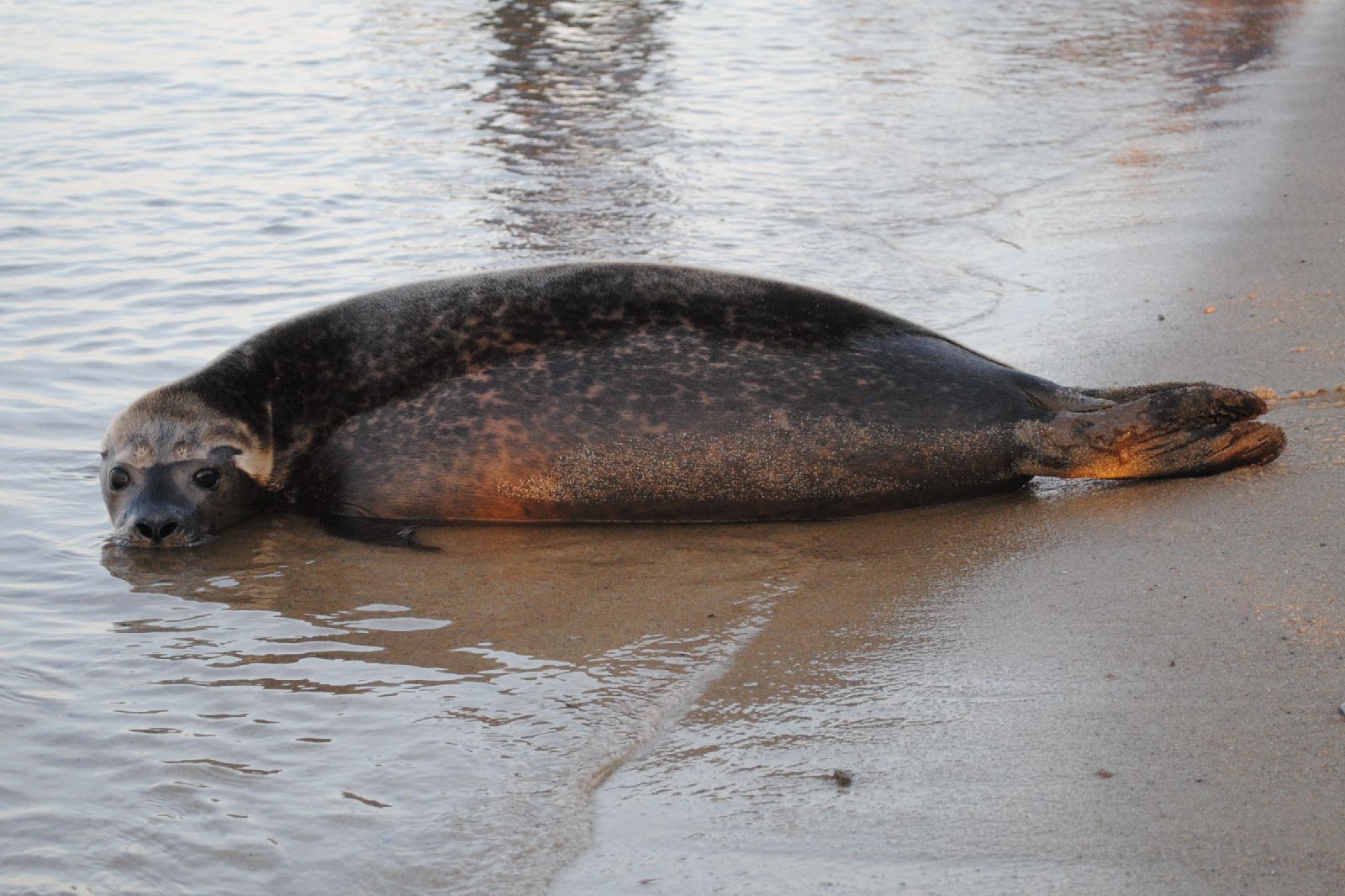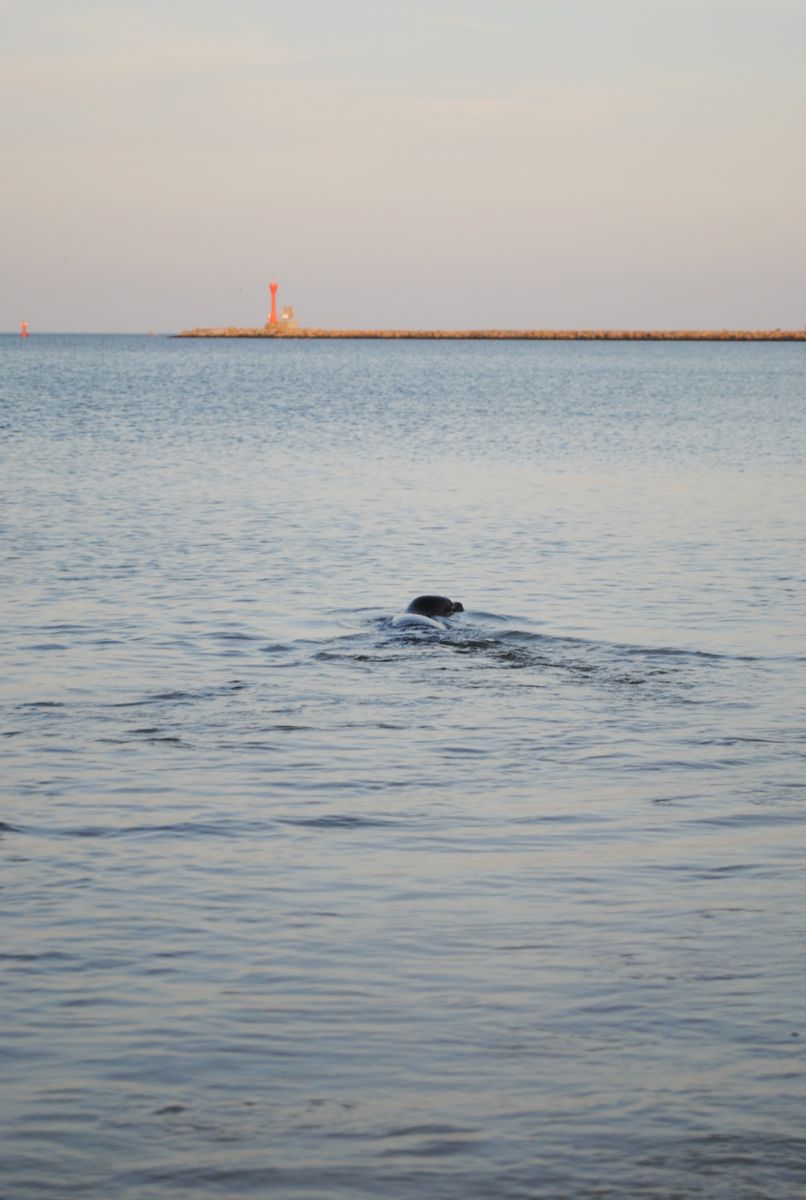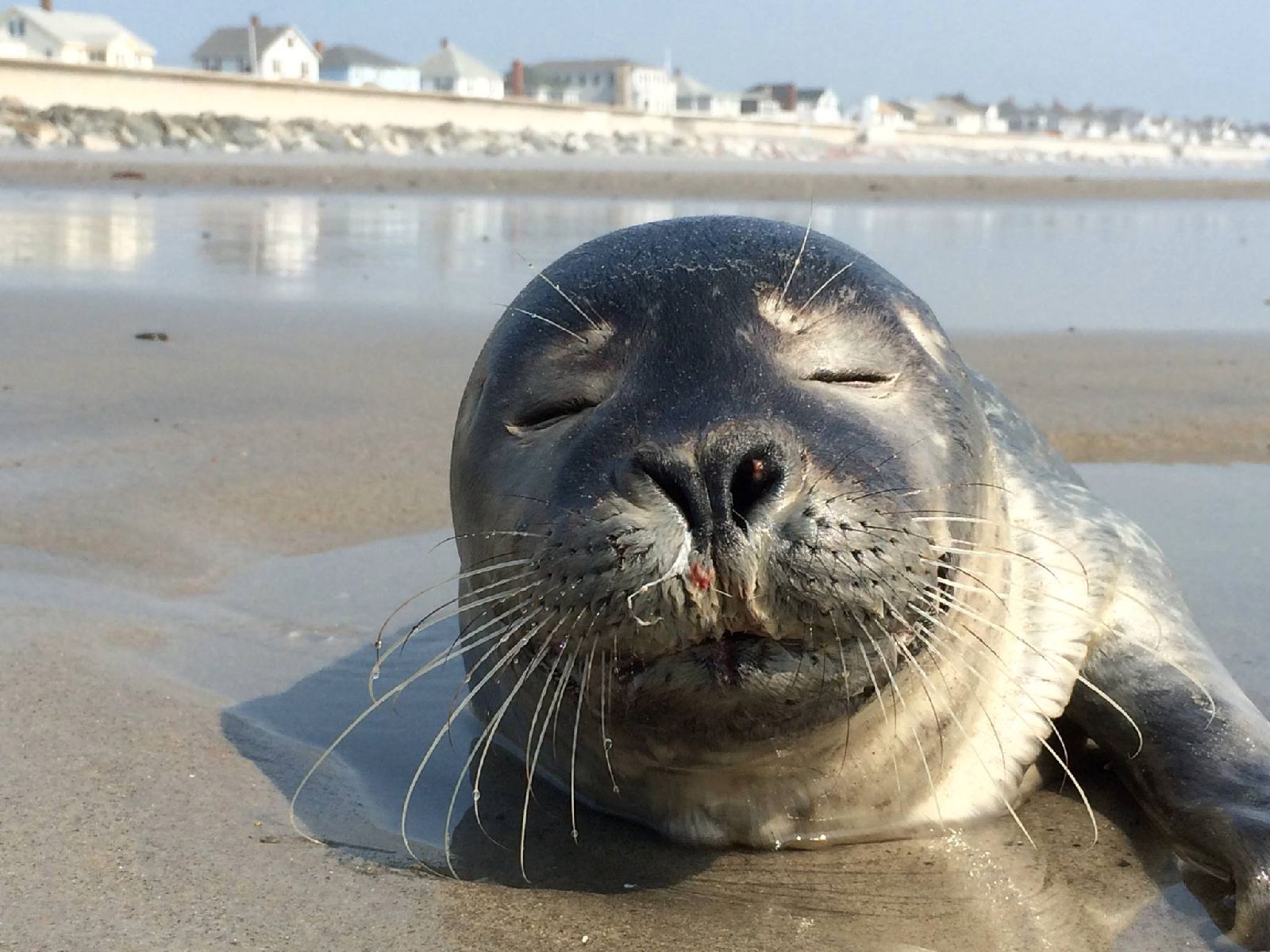News Posts List
News from the Marine Mammal Rescue Team 2014
12/31/2013
December 1, 2014
MMRT Assists New England Aquarium with Mass Turtle Stranding
Unprecedented number of cold-stunned, stranded sea turtles transported South for rehabilitation
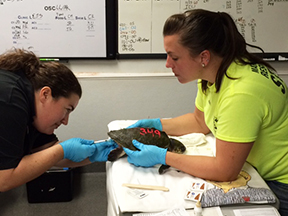 |
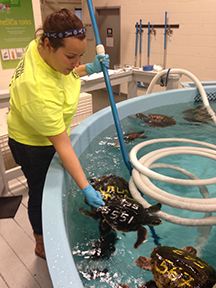 |
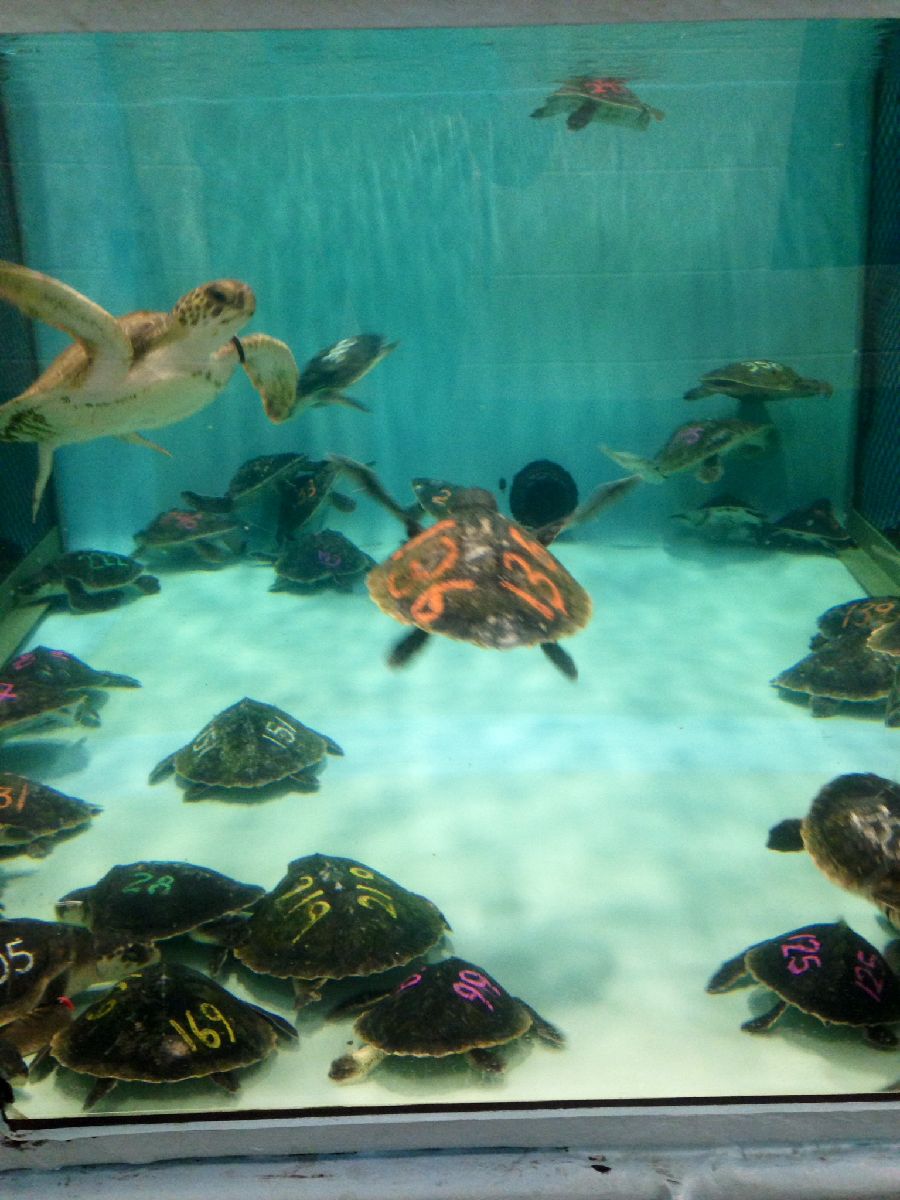 |
Photos courtesy of New England Aquarium
Our Marine Mammal Rescue Team stepped up to assist the New England Aquarium’s Marine Animal Rescue Program to respond to a record number of cold-stunned, stranded Kemp’s ridley turtles.
Kemp’s ridleys are the most endangered sea turtle in the world. As juveniles, they migrate annually to the warm waters off of Cape Cod to feed on the abundance of crabs. Many of the young animals end up in Cape Cod Bay on the north side of this huge, backward L shaped peninsula and unable to figure out the tricky navigation out of the bay and slowly become hypothermic as sea temperatures decline during autumn.
According to SSC Marine Mammal Rescue Coordinator Ashley Stokes, “Our rescue team is not specifically trained in sea turtle rescue because turtles do not strand on New Hampshire beaches. But, when the Greater Atlantic Regional Stranding Network put out a call for help, our team was ready to lend a hand. SSC President Wendy Lull, Rescue Assistant Sarah Toupin and I assisted with intakes, supervised swim time for the turtles, feeding, clinical treatments, and preparing the animals for transport.”
“The level of efficiency and organization at NEAq’s Animal Care Facility was impressive. Everyone, from trained NEAq staff, volunteers and interns, to stranding network staff, was intently focused in their role to help save these amazing endangered sea creatures. The Seacoast Science Center is pleased to be a part of the Kemp’s ridley sea turtle rescue effort and is standing by to assist throughout the stranding season.”
With only a third of the sea turtle stranding season behind them, the New England Aquarium has already provided life restoring veterinary care to over 650 sea turtles. Over 250 sea turtles in stable condition were flown out to Florida, Georgia, and North Caroline in past days to be distributed to rehabilitation facilities there. Hundreds of sea turtles remain in the Aquarium’s care in various stages of the rewarming and care process. Turtles continue to wash up on the beaches during the twice-daily high tides.
Volunteer walkers from the Massachusetts Audubon Society comb dozens of miles of beach in search of the sea turtles. Stranded turtles are brought to veterinarians at the New England Aquarium facilities with extreme hypothermia, severe dehydration, pneumonia and often shell or bone fractures. Their treatment can last from several months to two years. The New England Aquarium has also rescued and treated many green and loggerhead sea turtles this season.
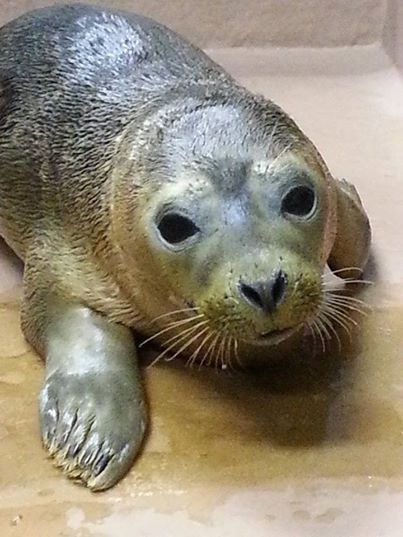 November 17, 2014
November 17, 2014
Update on Kennedy
Great news! Kennedy, the female weanling harbor seal rescued on Straws Point Beach in Rye, NH on October 14 ate fish on her own today at the National Marine Life Center! The crew there has done an amazing job with Kennedy, who was brought to them with a broken jaw, facial injuries, respitatory distress, dehydration, and malnourishment. Go Kennedy!! Photo by NMLC.
October 30, 2014
Deseased Seals on the Beaches
Our Marine Mammal Rescue Team hotline has been receiving many calls about deceased seals on the beach over the past two months. This is the time of year when we are more likely to see carcasses of young harbor seals. Harbor seals, like Kennedy (see below), are born around beginning of June and they are only with their mother for 3-4 weeks before weaning and becoming completely independent. Young seals (or weanlings) that have not become proficient at hunting for food are not as strong and healthy as those who have mastered catching fish. When they aren't feeding enough, they become malnourished, making them more susceptible to injury and disease.
If you see a seal carcass on the beach, please check to see if it is marked with a pink paint stick. If it has been, that means our team has already responded and collected all required data and photographs. If not, please call the MMRT hotline at 603-997-9448 and report its exact location along with the other information requested in the voice mail box recording. Please note that we do not typically remove carcasses from the beach; rather we let mother nature take course. If necesary, we will make arrangements to have the animal removed.
October 29, 2014
Kennedy is a Fighter!
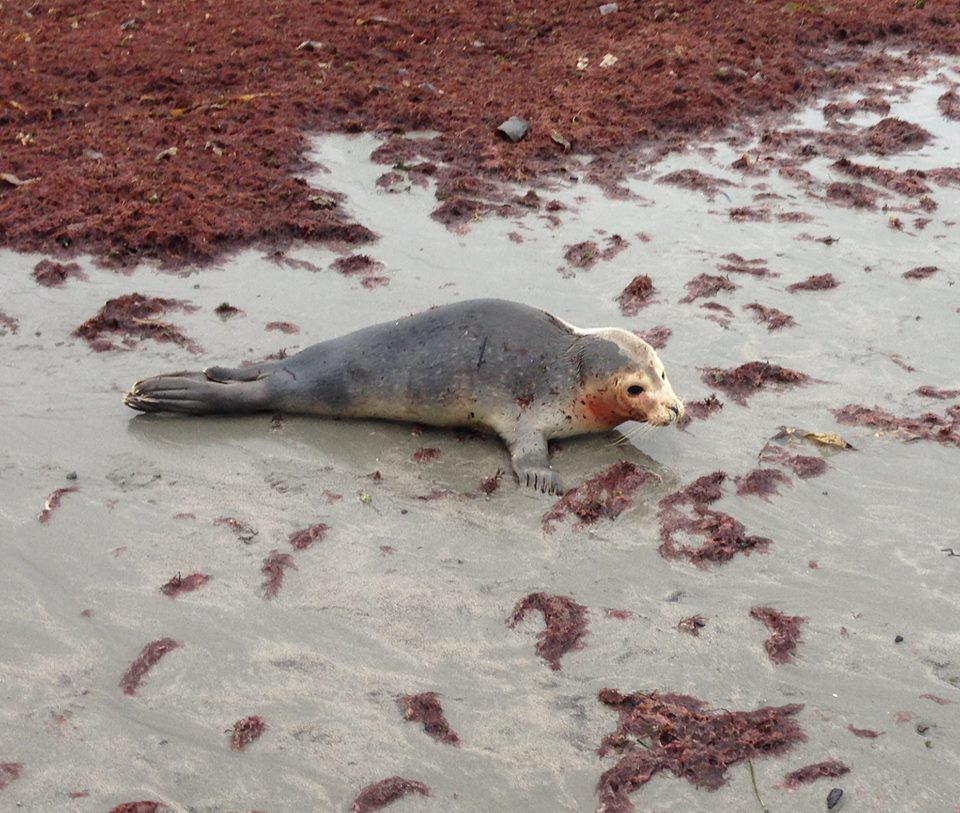 |
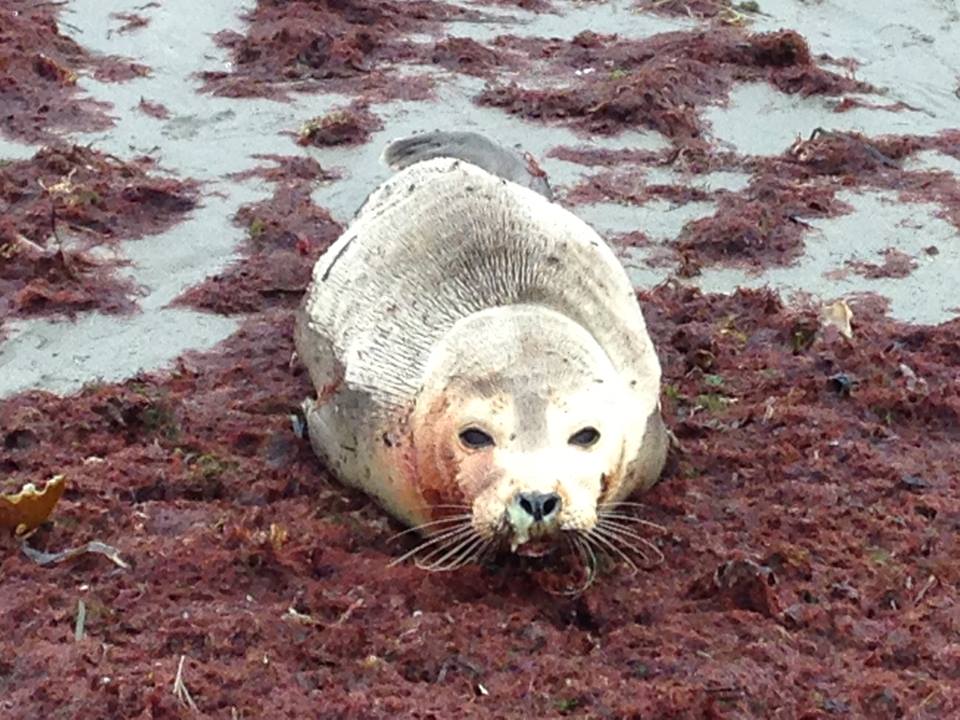 |
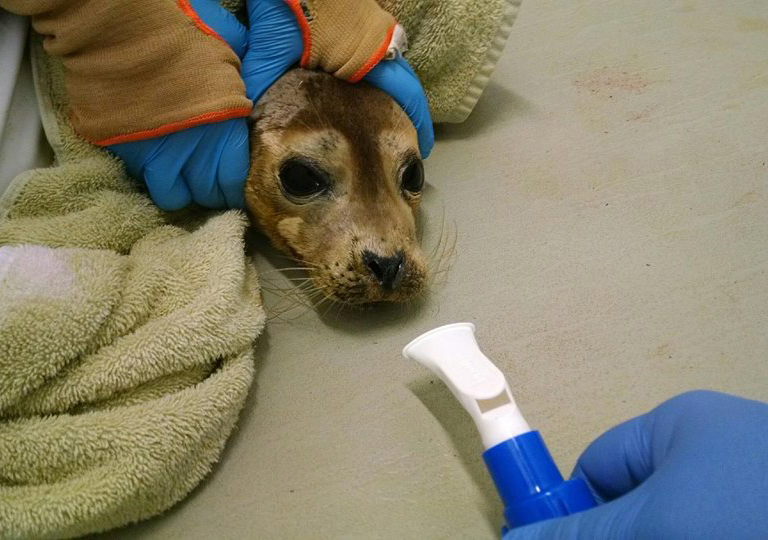 |
We responded to a very sick and injured weanling harbor seal on Straws Point Beach in Rye, NH on October 14. Upon initial assessment, we found that she had a great deal of discharge from her nose (suggesting a respiratory infection), small lacerations on her flippers, and a broken lower jaw. We transported her to the National Marine Life Center (NMLC) in Buzzards Bay, MA for rehabilitation, where she was given the name Kennedy.
Kennedy's prognosis was grim. She was diagnosed with a lung worm infection, which caused pneumonia. In very critical condition, it was doubtful that Kennedy would make it through the next day or two. NMLC's veterinarian recommended a special treatment for Kennedy using a nebulizer to vaporize medication into small particles that she would breath directly into her lungs. Thanks to generous gifts from NMLC supporters, a nebulizer was purchased, and Kennedy is now receiving treatments 2 times per day. While Kennedy is far from "out of the woods" at this point, she has proved to be a fighter and is still fighting today.
(Far right photo by National Marine Live Center)
September 29, 2014
Belmont the Seal Sculpture Funded!
Thanks to the generosity of local residents, the stone sculpture of a juvenile harbor seal will now permanently sit by the main entrance of the Seacoast Science Center. Created by Kittery artist Thomas Berger, the granite sculpture captures the attention of all ages and is the hallmark that inspires the Center’s visitors to learn about seals and other marine mammals of the Gulf of Maine.
The challenge to raise funds to purchase the art came from another seacoast artist and long time supporter of the Center, Marcia Gibbons. To inspire others to give, Gibbons made a $1,000 gift toward the $4,300 cost to purchase the piece of art.
“Within 10 days of putting the word out all of the funds were raised,” said Seacoast Science Center Marketing Director Karen Provazza. “Additional gifts were made to cover the cost of the plaque that will accompany the sculpture. We were delighted by the generosity and supportive feedback from the community.”
According to Provazza, “The sculpture not only helps to raise awareness of the Center’s Marine Mammal Rescue effort, it commemorates the Rescue Team’s first rescued seal, Belmont, who was rehabilitated and released back into the wild in September.”
Special thanks go to donors Gillian Aguilar, Armistead and Lousie Dennett, Arnold and Jean Dickinson, Mitchell and Karthryn Drew, Marcia Gibbons, Shirley Harper, Mark and Sue Hollingsworth, Arthur and Sally Kendrick, Vance and Anne Morgan, and Zoe and Christian Santilli.
September 12, 2014
Rose Returns to Wild!
 |
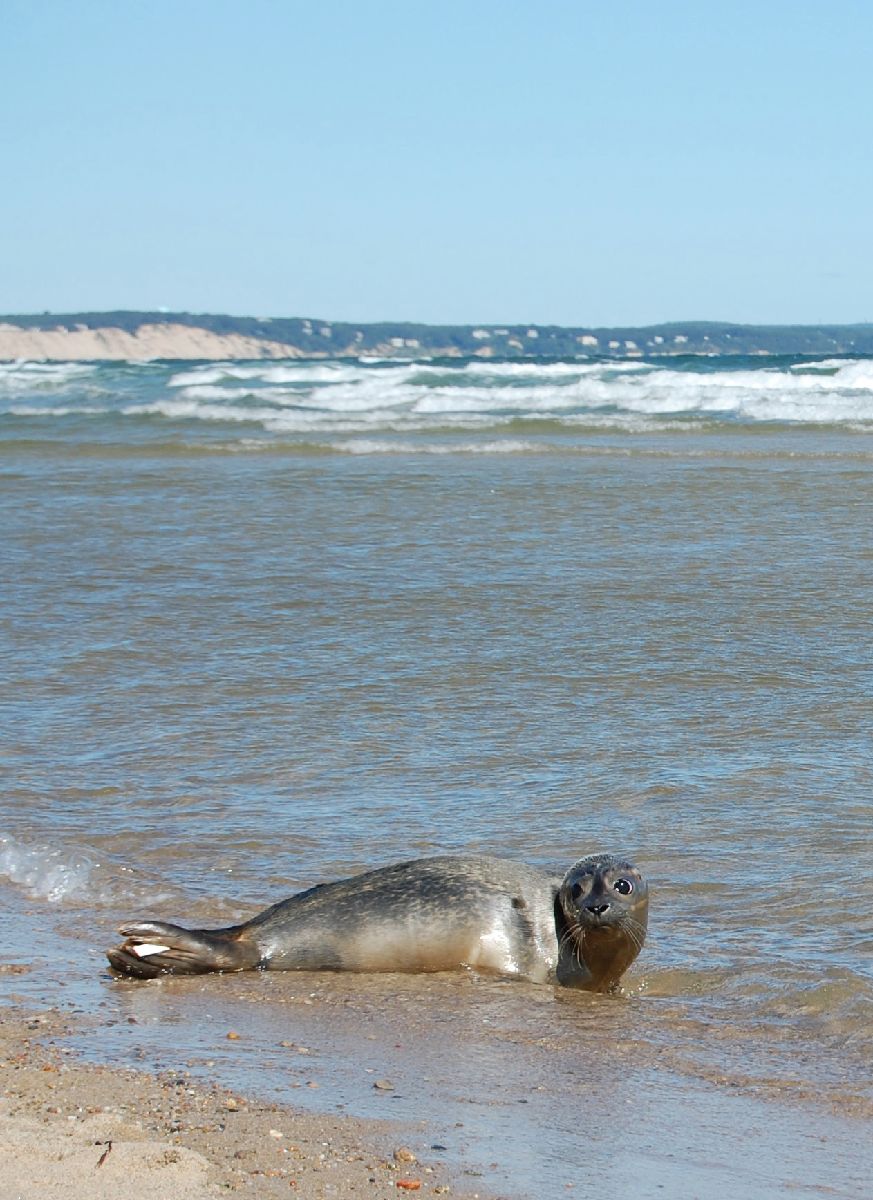 |
Rose, the harbor seal pup our Team rescued off of Star Island on June 10th, was released back into the wild in Sandwich, MA on September 12 after spending the 3 months in rehab at National Marine Life Center in Buzzards Bay!
September 6, 2014
*** THANK YOU! WE HAVE REACHED OUR FUNDRAISING GOAL! ***
Please help save the seals by donating to our Marine Mammal Rescue and Ocean Education Fund now!
Local Artist Challenges Others to Give to Keep Sculpture at SSC
The release of Belmont, the first seal rescued by the Marine Mammal Rescue Team, has inspired local artist Marcia Gibbons to challenge the community to donate funds to keep Thomas Berger's Harbor Seal sculpture at the Center to commemorate the event. More...
September 2, 2014
Belmont Released Back into Wild!
Belmont is the first seal rescued for rehabilitation by the MMRT to be released back into the wild!
|
Hampton Harbor, April 30, 2012 |
MMRT's Ashley Stokes & Rob Royer |
National Marine Wildlife Center, Feeding |
|
National Marine Wildlife Center, Pool |
Scusset Beach, Sandwich, MA, September 2, 2014 |
|
Yes, this is where you are supposed to be. |
Go Belmont, go! |
Belmont, a harbor seal pup rescued off the beach in Hampton Harbor this spring, is NH Marine Mammal Rescue Team’s (MMRT) first rescued animal to be released back into the wild. After four months of rehabilitation the healthy juvenile seal swam off to a crowd of cheers at the Scusset Beach State Reservation in Sandwich, MA Tuesday evening, September 2nd.
According to MMRT Coordinator Ashley Stokes, “This marks a great day for our Team and for marine mammal rescue in New Hampshire. It reassures us that the hard work we are doing is making a difference! It is very exciting to see one of ‘our animals’ being released.”
“We first received a call to our hotline about the pup the morning of April 29,” said Stokes. “The caller stated that a gentleman was petting the seal and his dog was at the site as well. Sure enough, when we arrived, there were human and large dog prints surrounding the pup.”
Many people do not realize that seals are only semi-aquatic and come on the beach to rest, nurse, and soak up the sun. A mother seal will not come back to retrieve her pup if there is a threat, and people and animals pose a threat. It is also dangerous and illegal to approach a seal; they are wild animals and could bite if provoked.
Belmont was estimated to be only 24-36 hours old when the Team first responded. The premature male pup had a full lanugo coat, which is the white coat that is normally shed before birth, and his umbilical cord.
“After observing the pup for 24 hours to see if the mother would return, we decided to transport the now weak and dehydrated animal to the National Marine Life Center in Buzzards Bay, MA for rehabilitation. Our goal is always to give an animal the opportunity to return to its natural habitat on its own, and in this case, to reunite with its mother during the early and critical bonding period,” said Stokes, “but this animal had no chance of survival without intervention.”
When the pup first arrived at the National Marine Life Center he was only 72cm in length and weighed 8.2kg. During this critical time he was tube fed a milk, fish oil and vitamin formula five times a day. After a few weeks he was transitioned from the formula to a ground fish formula and then introduced to whole fish. Once he figured out how to eat whole fish on his own he was weaned off of tube feedings all together.
The next feat in rehab is for the seal to show he can track, catch, and eat fish on his own. This is typically done using small fish like minnows. Once a seal is healthy, off of any antibiotics, hunts and eats fish on his own, and has reached a weight of at least 23kg (50lbs), approval for release is applied for through NOAA.
Stokes and MMRT assistant Sarah Toupin were present for the release. While Belmont was somewhat reluctant to dive into his vast new world, he eventually made his way down the beach and swam off.
The Marine Mammal Rescue Team has responded to over 40 animals this year. The team conducts health assessments, collects data on live and deceased animals, collects photographs, provides data to a national database that helps to advance marine mammal biology and ecology, and protects the health of stranded animals by preventing harmful human interactions.
Federal funding for marine mammal rescue operations has been vastly reduced. That means the Center relies heavily on contributions from its coastal communities. To help keep the Team ready to respond please consider making a tax-deductible donation here. If you contribute today, your gift will be doubled thanks to long time donors Cyrus and Bobbie Sweet. To inspire others to help, they have issued a challenge: they will match every dollar that is donated to the rescue fund this year—up to $20,000.
If you spot a seal or any other marine mammal on a New Hampshire beach call the Seacoast Science Center's Marine Mammal Rescue Hotline at 603-997-9448 and provide as much information about its location and the situation as possible.
To learn more about the Seacoast Science Center and its Marine Mammal Rescue effort visit click here, keep up-to-date at facebook.com/nhmarinemammalrescue, or call 603-436-8043.
August 25, 2014
Plaice Cove Harbor Seal Succumbed to Illness
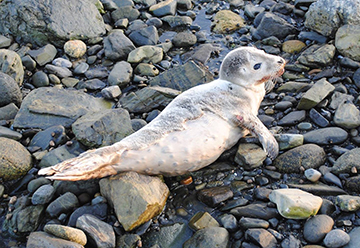 The MMRT decided to remove this very sick harbor seal weanling from Plaice Cove in Hampton. The seal had open wounds on his flippers, abcess-like bumps all over his abdomen, and his breathing was very labored/wheezy/congested. We wanted to give him the best chance we could, so we made the trek down to National Marine Life Center in Buzzards Bay, MA. This seal had pneumonia, as well as seal pox, which is similar to human chicken pox. Unfortunately, on Tuesday afternoon, he succumbed to the infections. The good news to this otherwise sad outcome is that we removed a very sick seal from the wild population, whose illness (the seal pox) was highly contagious to other seals.
The MMRT decided to remove this very sick harbor seal weanling from Plaice Cove in Hampton. The seal had open wounds on his flippers, abcess-like bumps all over his abdomen, and his breathing was very labored/wheezy/congested. We wanted to give him the best chance we could, so we made the trek down to National Marine Life Center in Buzzards Bay, MA. This seal had pneumonia, as well as seal pox, which is similar to human chicken pox. Unfortunately, on Tuesday afternoon, he succumbed to the infections. The good news to this otherwise sad outcome is that we removed a very sick seal from the wild population, whose illness (the seal pox) was highly contagious to other seals.
August 24, 2014
Harbor Seal Weanling — Plaice Cove, Hampton
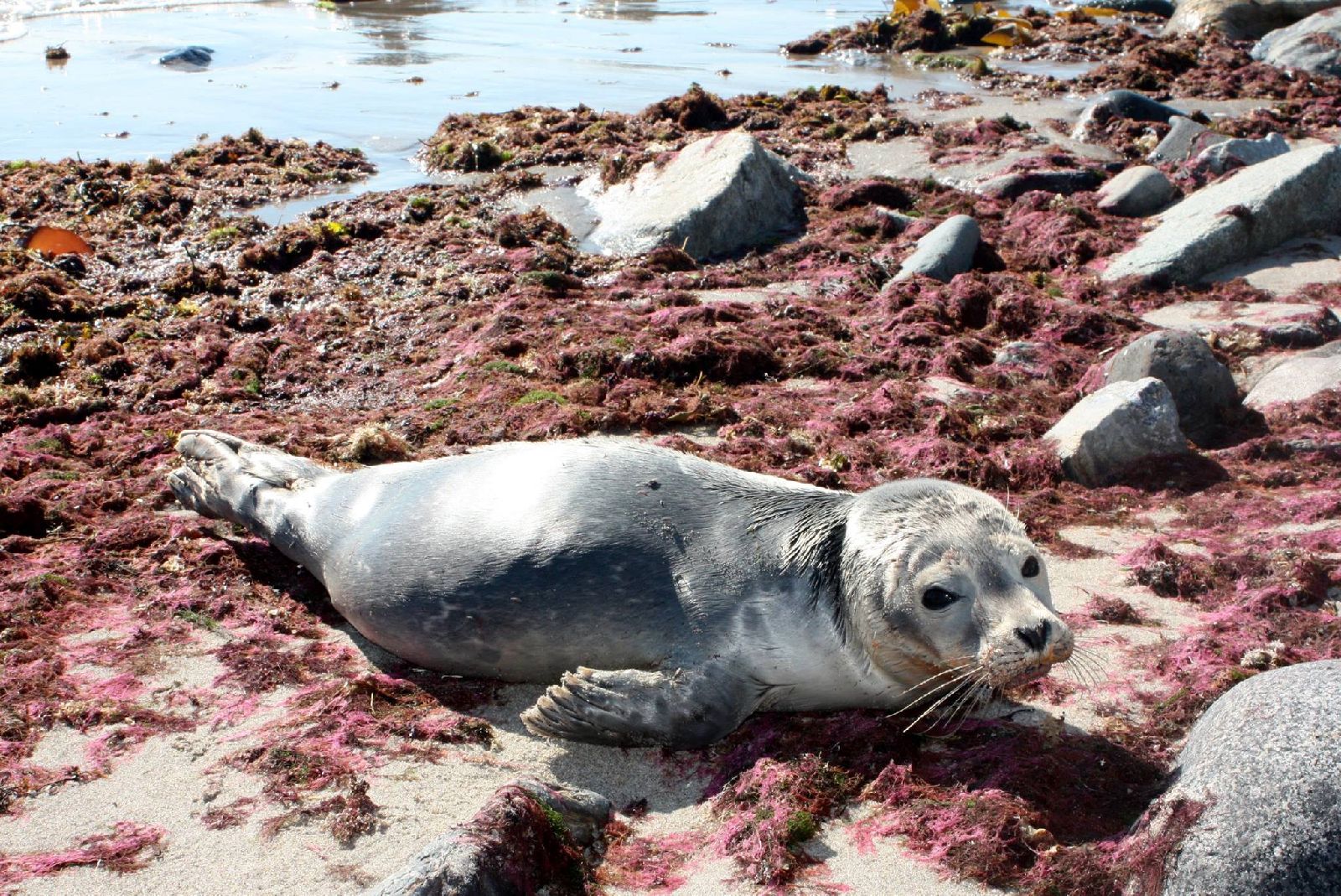 |
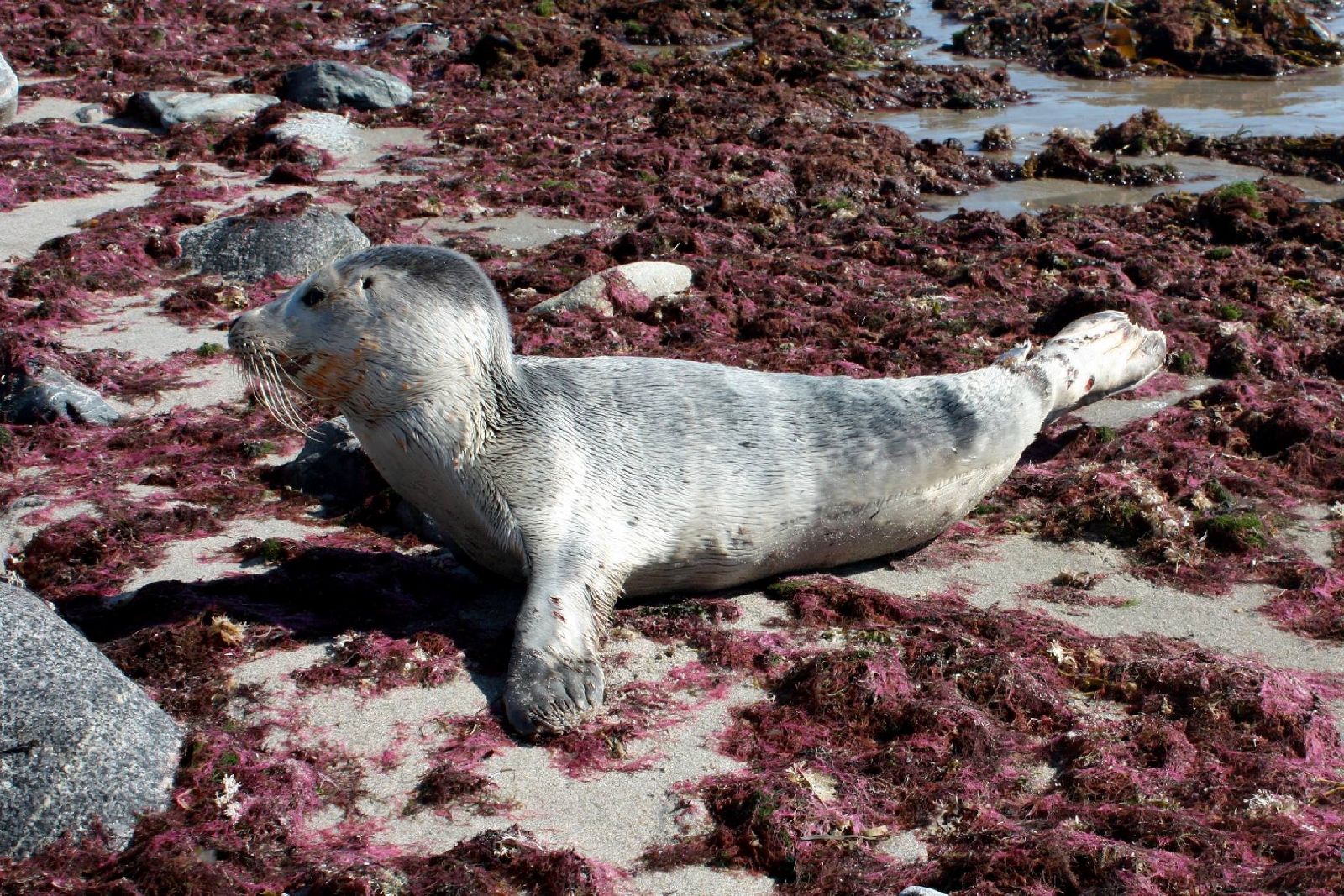 |
Early Sunday morning, August 24, we received reports of a small seal in Hampton near Plaice Cove. Upon arriving, the incoming tide had already forced the seal back into the water. But a short time later we received more reports a very short distance away, that the seal had hauled back out. We went back to the scene and found a small harbor seal pup. He did have some lacerations on his flippers, but was very alert and feisty other than that. We monitored him for a short while and he retreated back to the water as we were completing our health assessment paperwork!
August 22, 2014
Young Harbor Seal Hauls out to Rest on a Jet Ski
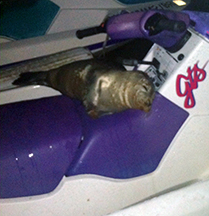 |
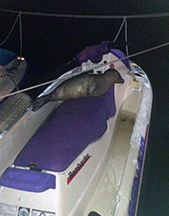 |
Late Friday evening, August 22nd, we received a report of this young harbor seal who chose to haul out to rest on a gentleman's jetski in Hampton! This seal appeared healthy and the man didn't mind that the seal chose to take a snooze on his jetski. After resting, the seal returned to the water on its own that night.
July 30, 2014
Salisbury/Hampton Harbor Seal
We were called on to respond to this harbor seal in Salisbury, MA, which boarders NH, on July 30. While she had lacerations in her mouth, they were not as bad as they appeared. In the fist photo, you can see field volunteer Jan B. educating beach-goers about the seal, while rescue coordinator Ashley Stokes conducted the health assessment prior to kenneling the animal. We chose to relocate this seal to a quieter beach where she quickly retreated back to the water. She hauled out again on August 1st in Hampton and we were glad to see her health and wounds had improved!
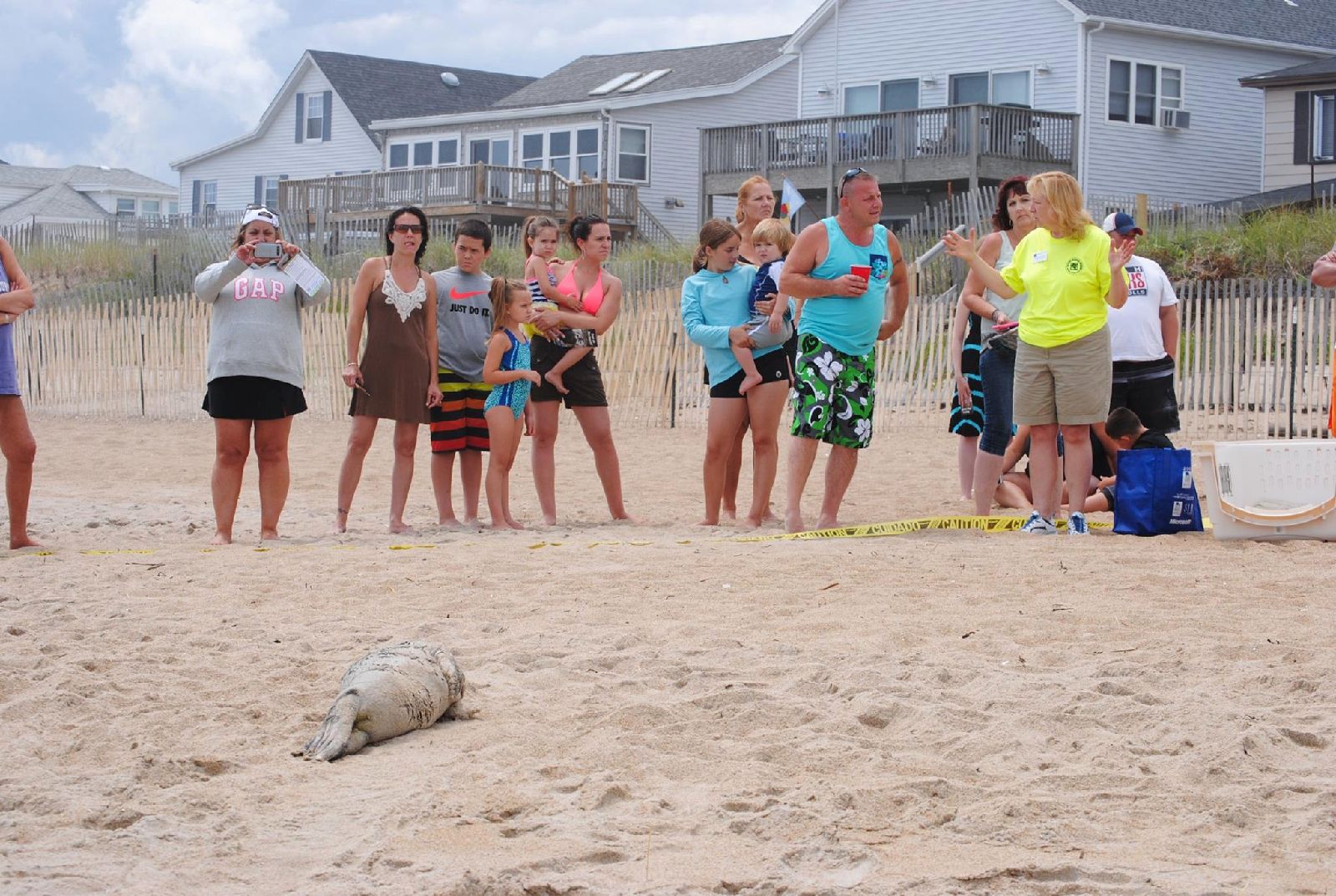 |
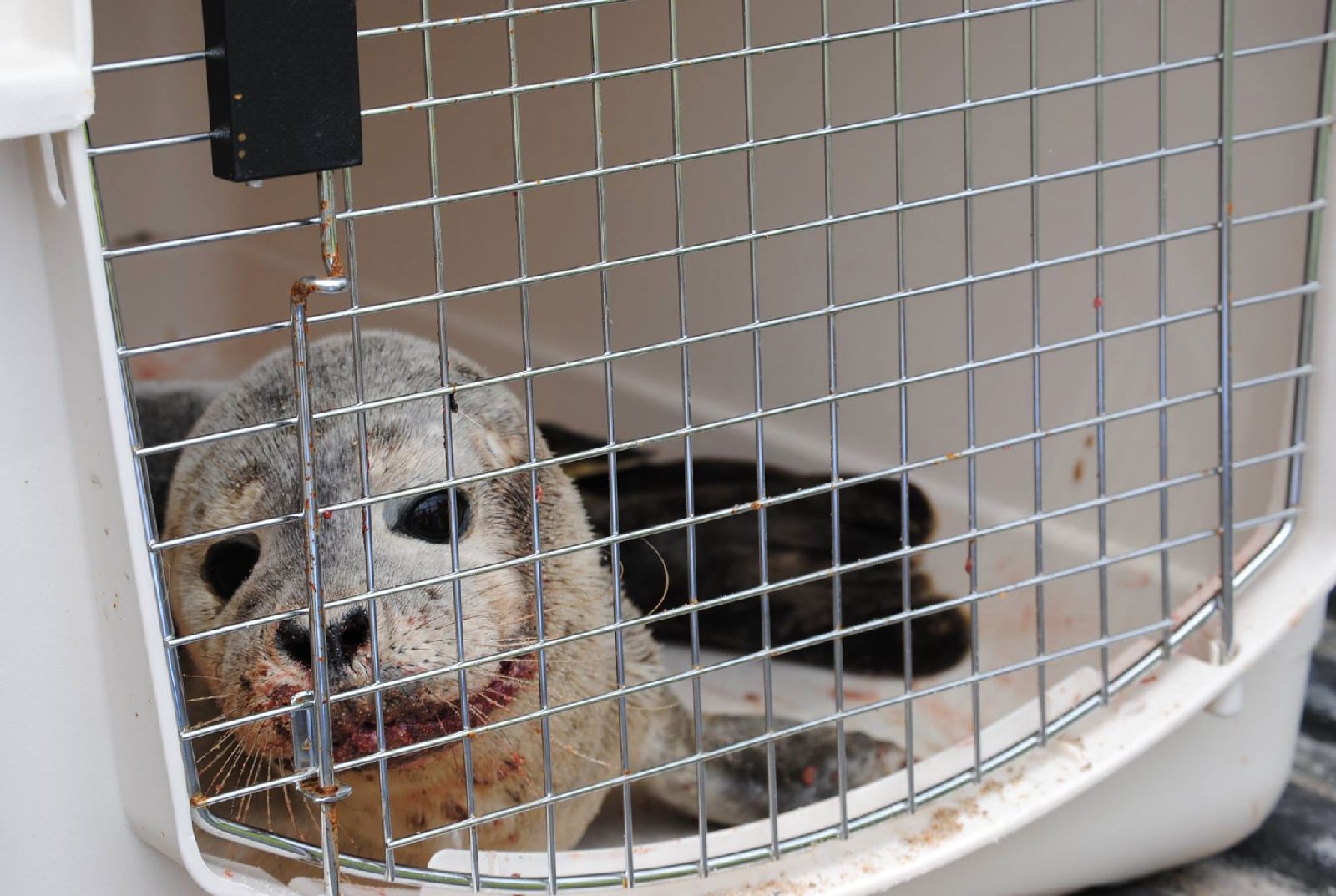 |
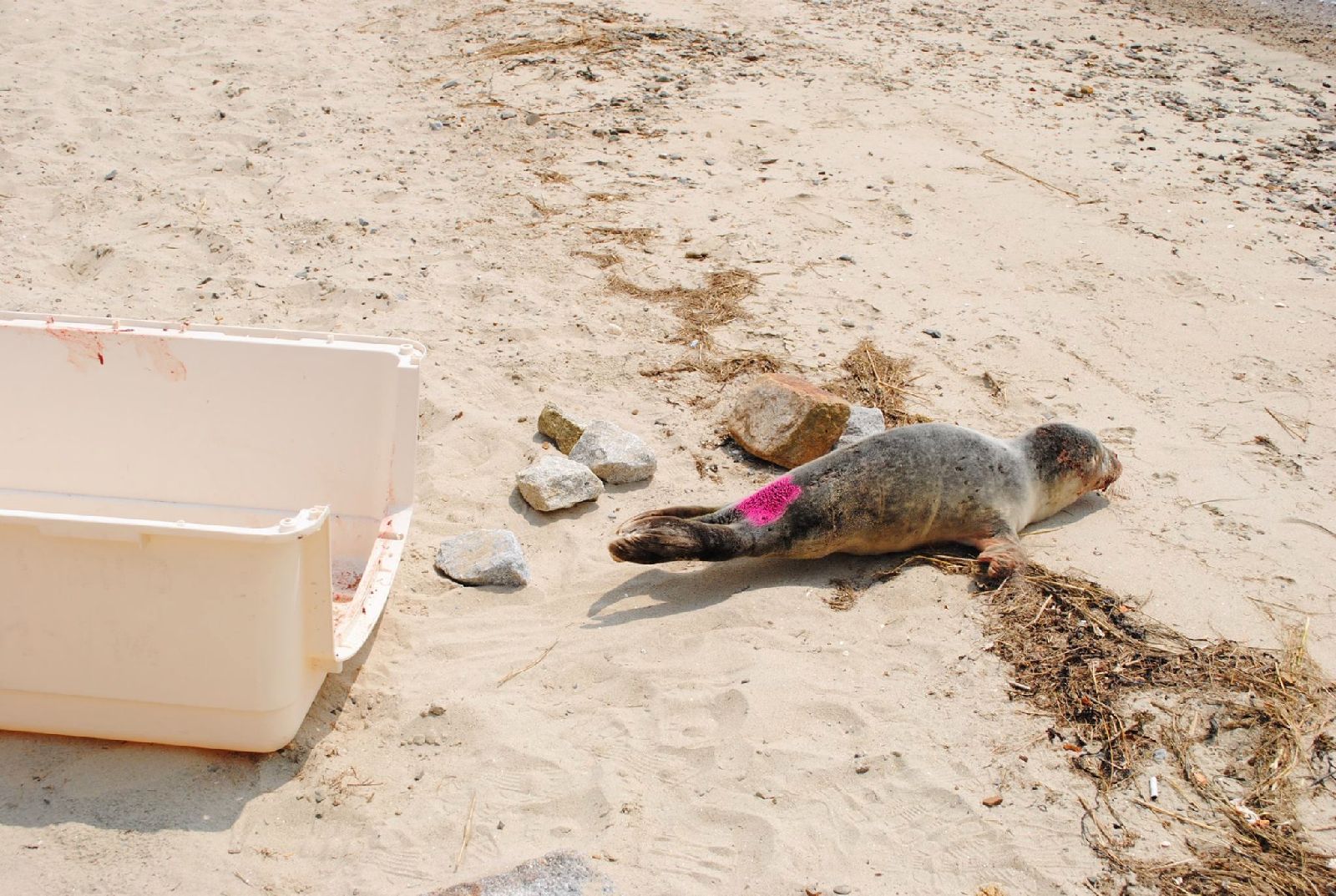 |
|
July 15, 2014
Belmont and Rose Update
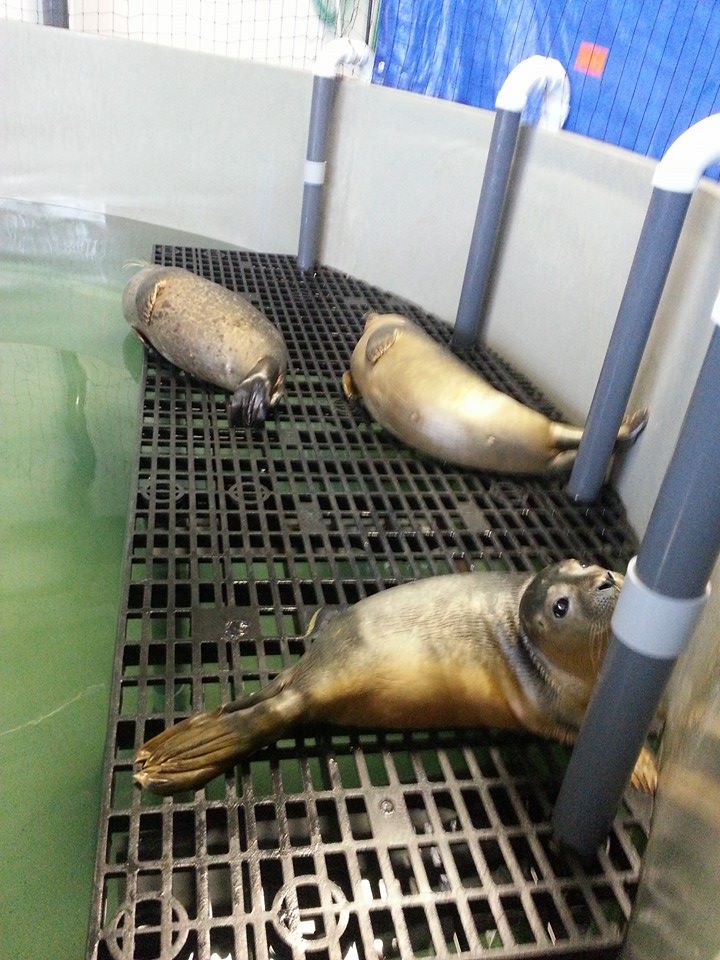 The two pups, Belmont (back left) and Rose (back right) we rescued and brought to rehab at National Marine Life Center earlier this season, along with a pup, Barclay (front), rescued by Marine Mammals of Maine, are all together in the big tank and they all look like they are doing great!
The two pups, Belmont (back left) and Rose (back right) we rescued and brought to rehab at National Marine Life Center earlier this season, along with a pup, Barclay (front), rescued by Marine Mammals of Maine, are all together in the big tank and they all look like they are doing great!
June 11, 2014
Emacited harb seal pup rescued at Star Island
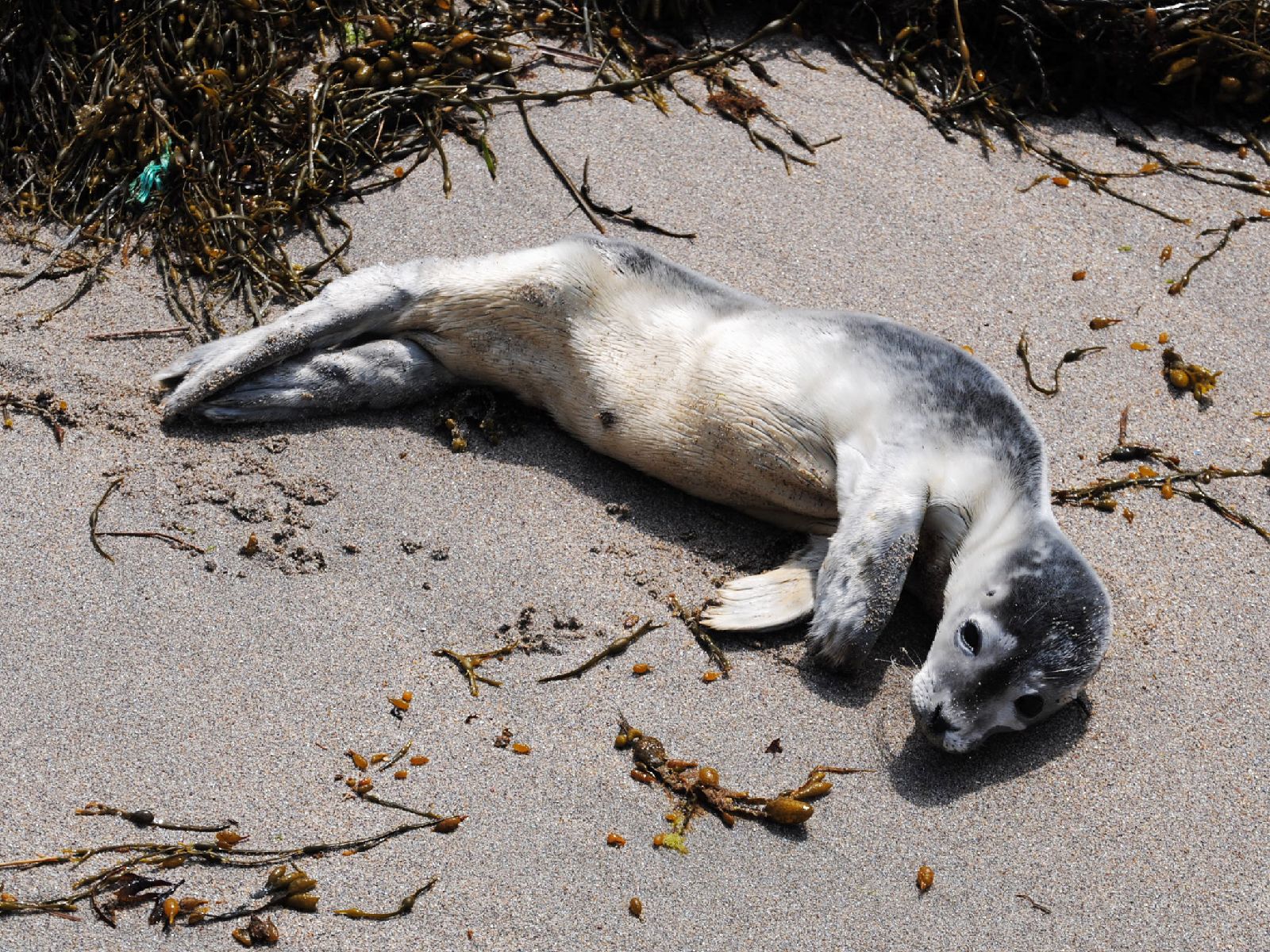 |
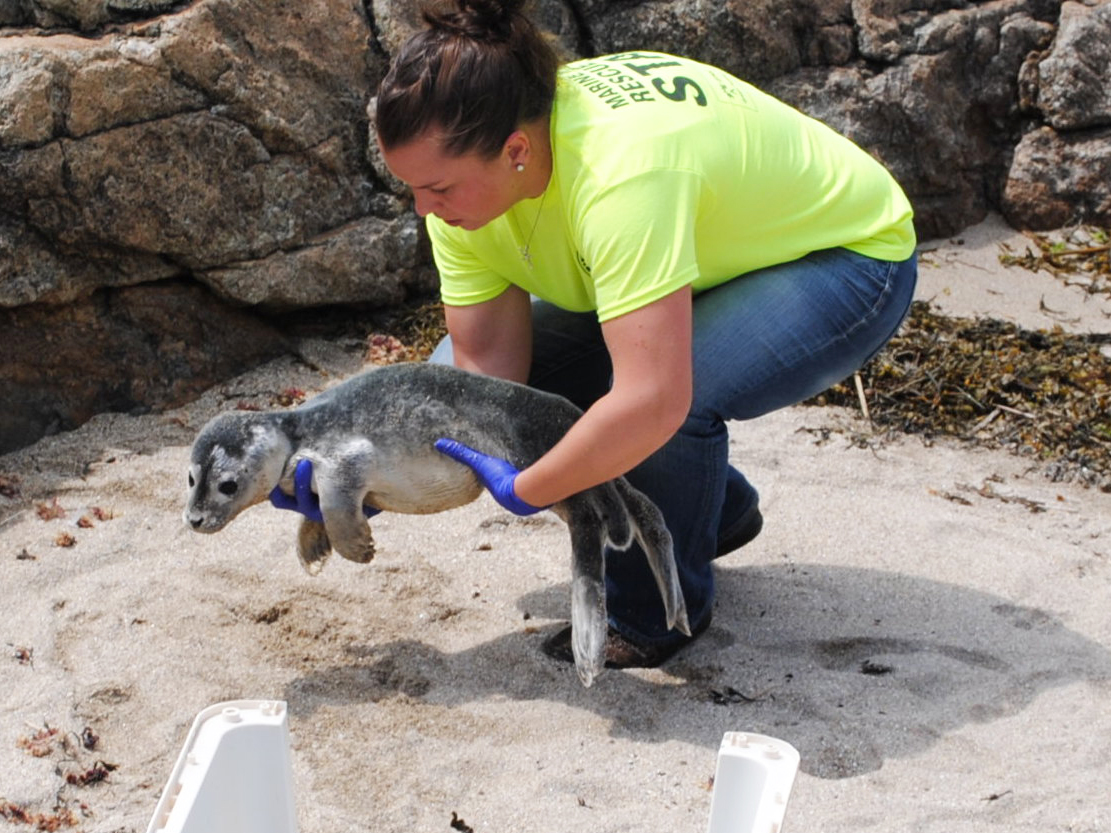 |
On Tuesday, June 10, our Marine Mammal Rescue Team (MMRT) rescued a week-old harbor seal pup at Star Island at the Isles of Shoals. MMRT coordinator Ashley Stokes and field volunteer Jen Kennedy, Executive Director of the Blue Ocean Society, rescued the pup, which they said was "extremely emaciated and dehydrated." The team's initial health assessment led them to believe the pup had not returned to the water since it was first spotted two days prior, and there was no sign that its mother was in the vicinity.
After reviewing the case with consulting veterinarian Dr. Gerry Beekman, Stokes made the decision to bring the seal to the National Marine Life Center in Buzzards Bay, MA for rehabilitation. After transporting the seal on the M/V Thomas Laighton to the mainland, Stokes and rescue assistant Sarah Toupin made the 2½-hour drive to Cape Cod.
"With limited rehab space following the closure of the University of New England's Marine Animal Rehabilitation and Conservation program, and longer drive times to the closest rehab facility, we face a tougher decision for choosing which seals should/can make the trek," Stokes said. "We are monitoring animals longer now, to give the mother the opportunity to return and to see if the animal can survive on it's own, without our intervention. This animal's health was rapidly decreasing and she was extremely thin, we made the decision that she should be taken to rehab.”
The seal pup was named Rose after the first boat to go through the Cape Cod Canal. Rose weighed just over 11 pounds.
Stokes said for safety of seals and other animals, it is important for people to stay away from seals and other marine mammals on the beach. Call the 24-hour hotline at (603) 997-9448) to report all sightings, live or dead, she said. You can follow Rose's progress on the New Hampshire Marine Mammal Rescue page on Facebook.
August 24, 2014
Harbor Seals Weanling Moved to a Quieter Beach
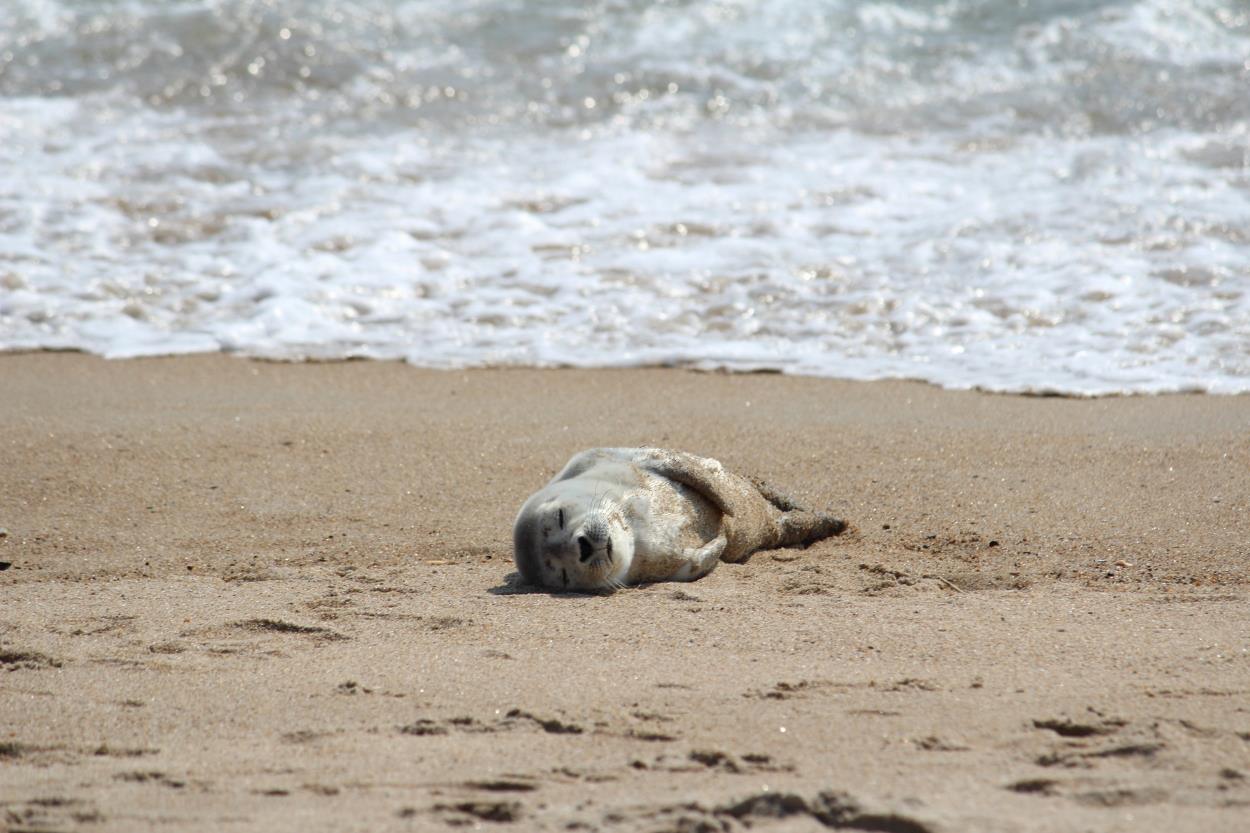 |
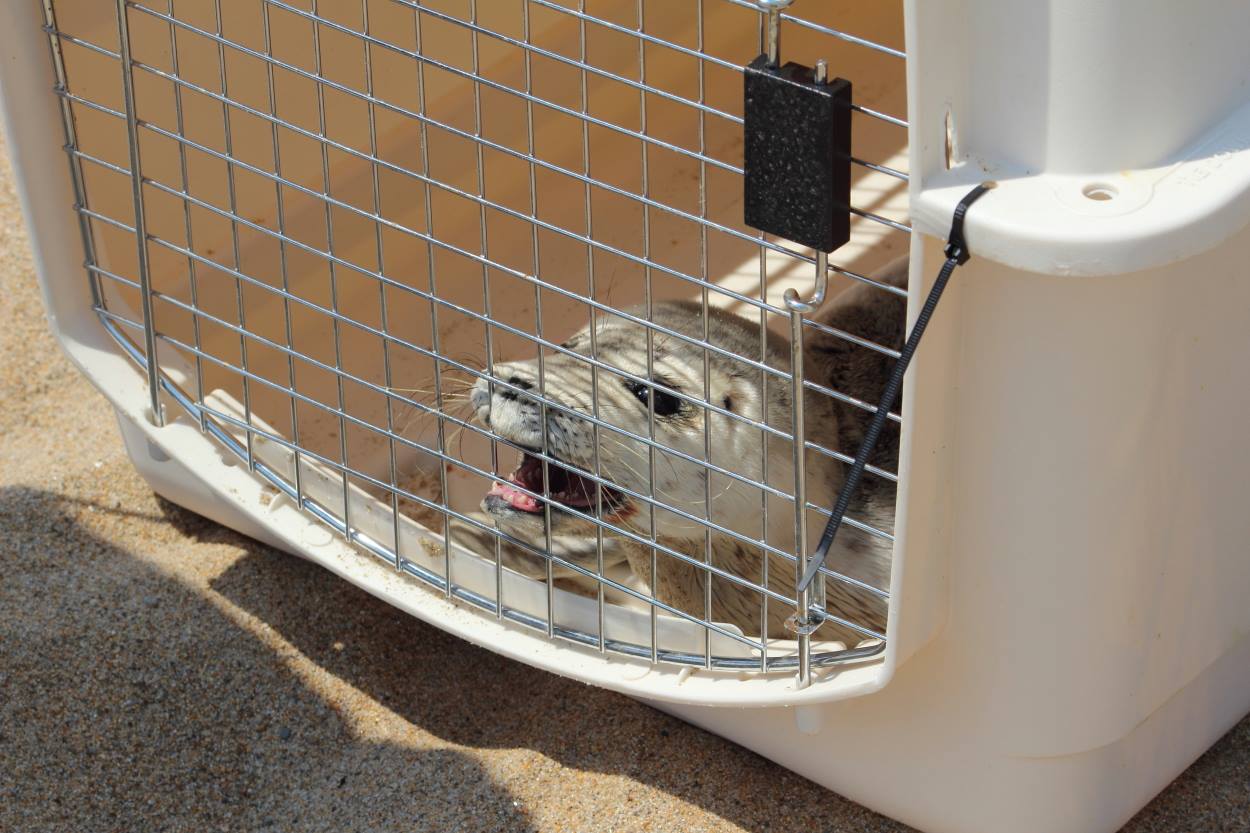 |
We responded to this weanling harbor seal pup in Salisbury on July 13. We relocated this animal to a quiet NH location to give it the time it needed to rest.
May 27, 2014
Rehab Center's Closure hurts Seacoast Seal Rescuers
Job becomes more difficult, local officials say
BIDDEFORD, Maine — Rescuing seals and other marine animals will be more difficult now that the University of New England’s Marine Animal Rehabilitation and Conservation program has closed, local rescue organizations said this week, but it will not stop them from trying.
“The rescue work will still be done,” said Wendy Lull, president of the Seacoast Science Center in Rye. “It just makes it harder.”
Since the start of this year, the Seacoast Science Center has led New Hampshire’s marine mammal rescue effort through authorization from the National Marine Fisheries Service. The center’s Marine Mammal Rescue Team responds to stranded, injured and diseased seals and other mammals along the New Hampshire coast in partnership with the New England Aquarium and MARC.
Prior to that, Lull said Seacoast Science Center staff volunteered as members of a local response network through the New England Aquarium.
The closing of the MARC program was announced last week on its Web site along with new undergraduate marine sciences programs, including a degree in ocean studies and marine affairs. The program was known for its regular seal releases, which attract dozens of community members. It routinely took in seals and other marine mammals from throughout New England, and especially those found on Maine and New Hampshire beaches.
“We’ve been doing marine rehabilitation since 2001 and we are, in fact, very proud of what we’ve accomplished as a group,” said Ed Bilsky, vice president for research and scholarship. “We’ve rehabilitated over 1,000 seals and released them back into the wild. The seal populations that were endangered are no longer endangered. On the other hand, we need to remember we are a university and we need to educate students and give them the skill paths they need.”
Bilsky said there are two full-time staff members and several volunteers, including students, who will be affected by the change.
Lynda Doughty, executive director of Marine Mammals of Maine, said she received a press release about the MARC facility’s closing just before the traditionally busy Memorial Day weekend. The news was “devastating,” she said.
“We do this because we want to try to help animals, but it makes our jobs even harder when there’s no place for them to go,” Doughty said.
She said this is the busiest and most critical time of year for marine mammal rescues as seal pups tend to be abandoned by their mothers.
“We were slammed this weekend with animals,” Doughty said, adding the organization responded to assist with 24 seal pups in the past two weeks. “Right now, we’re trying to coordinate a transport to Mystic Aquarium in order for a couple animals to go. We really have to prioritize which animals go because there’s such limited capacity for the volume we see in the next two months.”
The Seacoast Science Center and Marine Mammals of Maine both have hotlines people can call to report a mammal they believe may be in need. When they get a call, the organizations deploy responders. Sometimes the animal is healthy and has hauled out on to land, which is part of what they normally do, but other times they need care and rehabilitation. In that case, the animals would often be transported to MARC.
The nearest rehabilitation facilities are now the National Marine Life Center in Buzzard’s Bay, Mass., and Mystic Aquarium in Mystic, Conn.
“They will have to receive these extra seals,” Bilsky said.
But space at them is limited, local rescue organizations said, and the longer trip will be difficult for the animals. Lull and Doughty said longer trips to Connecticut will require them to extend the length of time they monitor animals.
“We were very excited when we first got into this,” Lull said. “UNE has a beautiful facility, good staff, they are really helpful, and logistically, it’s a lot easier for us to transfer animals to Biddeford.”
She added the impact of the closing is two-fold.
“There’s the logistics and expense of taking animals further to rehab — it adds a 200-mile round trip for us — and then there’s a time factor,” Lull said. “The time it takes to transport the animal takes a responder out of the field, ties up a response vehicle longer. But it also changes the decision that you’re going to make about the fate of that animal.”
Lull said her team will meet with its consulting veterinarian and seek guidance from National Marine Fisheries to determine what will be the best course of action for rescued animals.
“There’s a lot of conversation going on among the stranding community about what is more stressful to the animal,” Lull said. “What’s in the best interest of the animal? Do you put it in the kennel and start driving and if it dies you turn around? “There are public and animal safety issues that have to be taken into consideration. If you are just going to get the animal away from people and put it somewhere else we have to identify a place for that.”
Over the weekend, Doughty said she had to put down a seal and one died in transport.
“We’re working on trying to find solutions because we know that this service is needed in Maine,” she said. “Right now we’re just trying to get through.”
May 5, 2014
Update on harbor seal pup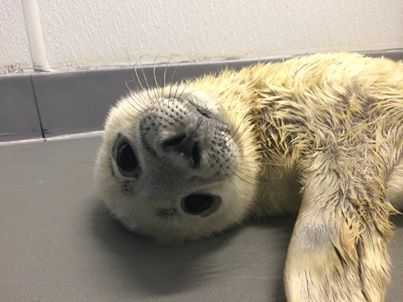
May 1, 2014
Baby seal pup abandoned by mom
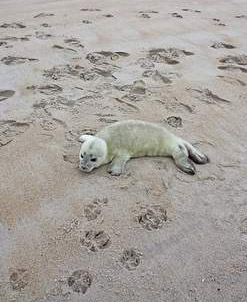 SEABROOK — The Seacoast Science Center's Marine Mammal Rescue Team reported it rescued a newborn harbor seal pup from the beach in Seabrook Wednesday morning, April 30. The pup was likely abandoned by its mother because people and dogs approached much too close, according to the team, which said there were foot prints and dog tracks circling the animal.
SEABROOK — The Seacoast Science Center's Marine Mammal Rescue Team reported it rescued a newborn harbor seal pup from the beach in Seabrook Wednesday morning, April 30. The pup was likely abandoned by its mother because people and dogs approached much too close, according to the team, which said there were foot prints and dog tracks circling the animal.
A mother seal will not return to her pup if it poses a threat, and evidence of human interaction is threatening, the rescue team said. The pup, about 24 hours old when first observed, looked healthy, but hungry. It had no chance of survival if it had not been rescued and transported to a rehabilitation facility.
Newborn pups nurse every few hours, around the clock. The National Marine Life Center in Buzzard's Bay, Mass., was the closest facility able to accommodate the pup's care at the time.
The rescue team first received a call about the pup on Tuesday morning and placed it under 24-hour observation. According to rescue team coordinator Ashley Stokes, "We monitored the pup before determining whether or not intervening was the best course of action. Our goal is always to give an animal the opportunity to return to its natural habitat, and in this case, to reunite with its mother during the early and critical bonding period."
Stokes said the rescue team protects seals that are under observation by posting signs and roping off the area and educates beach-goers about protecting them.
Many people do not realize seals are only semi-aquatic and come up on the beach to rest, nurse, and soak up the sun. It is dangerous to approach a seal; they are wild animals and could bite if provoked, the rescue team said.
This male harbor seal pup was 72 centimeters long and was crying out for its mother.
Harbor seal pupping season occurs in May and early June and beach-goers are much more likely to encounter a pup on the shore during this time.
Here is how to help if you encounter a seal or other marine mammal on the beach:
- Call the 24/7 hotline at (603) 997-9448 and report the animal's location, size, coloring and behavior.
- Watch quietly from at least 150 feet away.
- Keep dogs away from the animal.
- Do not offer the animal food or water.
- Do not pour water on the animal.
- Do not cover the animal with a towel or blanket.
- Do not try to move the animal.
To learn more about the Marine Mammal Rescue program, visit www.seacoastsciencecenter.org/mmrt and "like" New Hampshire Marine Mammal Rescue on Facebook.
April 18, 2014
Don't go near that seal pup!
Seacoast's new Marine Mammal Rescue Team has important mission
By Deborah McDermott, Seacoast Media Group
RYE — It's that time of year again. Gray seals are just about wrapping up their birthing season and harbor seals will soon begin, so the chances of encountering a mother and pup or a lone pup on local beaches increase.
In nearly all cases, they are not sick, only resting. Not only should they not be touched or approached by a human or dog, it's against federal law to do so. So the message from marine rescue organizations is to steer clear and call the local rescue hotline.
IF YOU SEE A SEAL
• Call the Seacoast Science Center's 24-hour Marine Mammal Rescue hotline at (603) 997-9448. Report the exact location, if it's alive or dead, and details about it's size, coloring and behavior
• Always maintain a safe distance of at least 150 feet from the animal to avoid injury to you or the animal.
This year, for the first time, that call will be a local one for Seacoast residents. The Marine Mammal Rescue Team at the Seacoast Science Center on Ocean Boulevard is involved in its first pupping season since it officially began rescue work Jan. 1. That is when the center joined the National Oceanic and Atmospheric Administration's marine mammal stranding network. In prior years, the New England Aquarium in Boston fielded calls.
The center's team is responsible for 238 miles of coastline and the Great Bay shore, offering a 24-hour hotline at (603) 997-9448 and rescue services.
“We're very excited about it,” said rescue coordinator Ashley Stokes. “Mainly, we're excited for the opportunity to educate people about what to do if they see a seal.”
The team is putting up signs on town beaches from Seabrook to New Castle, asking people to keep their distance from seals. This will be a first for New Hampshire beaches, she said. They are currently working to get permission to put the signs on state beaches as well. The team has already fanned out to area towns, particularly police departments that often receive calls from people, and intends to do more outreach in the months to come.
Stokes said seals are only semi-aquatic, adding “They like to spend a portion of their time on land, resting. Unfortunately, they will haul out on sandy beaches, and those are the same beaches where people like to congregate.”
Maggie Mooney-Seus at NOAA's Greater Atlantic Region office agrees. “These are wild animals and you want to respect that,” she said. “Federal law mandates that you have to keep a 150-foot distance from them. Another reason to keep your distance is that seals bite. They can hurt you or your dog and sometimes they can transmit disease to dogs. You don't want to open that vector.”
Although the Seacoast in winter — particularly this past cold winter — may see “ice seal” like hooded and harp seals coming down from Canada, gray and harbor seals are much more common here. The gray seal pupping season is just about wrapping up, Stokes said. Harbor seal pupping season begins next month.
“A mother seal may just be off feeding when someone comes across a seal pup on the beach,” she said. “She'll leave the pup on the beach to hunt.”
People could see harbor seals on beaches through the summer, she added. Pups are weaned after only 21 days, she said, and the “weanling” seals often show up on beaches in July and August. “They are not pros at hunting for food on their own and they haven't learned yet that people aren't their friends,” Mooney-Seus said.
The bottom line is to stay clear and call the professionals. “That's what we're here for,” she said.
April 9, 2014
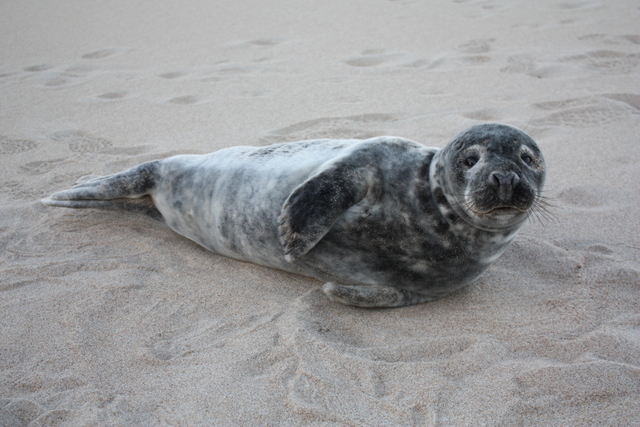
March 20, 2014
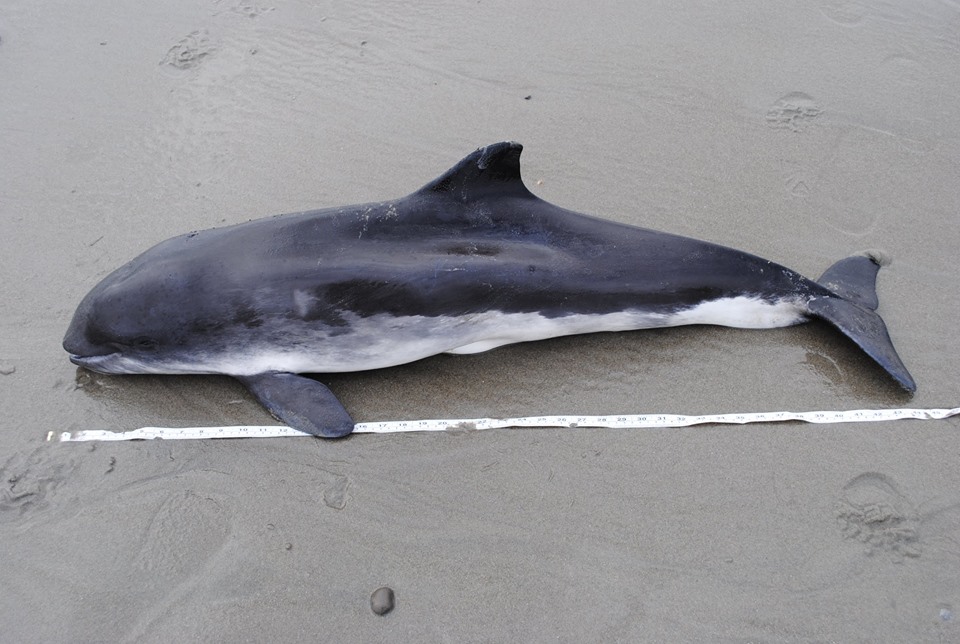 Today we responded to our first animal in Rye, who also marked the first Cetacean species of 2014; a deceased male Harbor Porpoise (Phocoena phocoena) on Jenness Beach. We took photos of the porpoise, as well as all required data and measurements.
Today we responded to our first animal in Rye, who also marked the first Cetacean species of 2014; a deceased male Harbor Porpoise (Phocoena phocoena) on Jenness Beach. We took photos of the porpoise, as well as all required data and measurements.
We can't be sure, because he was not taken in for necropsy due to heavy scavenger damage to the right side of his body. But looking at body condition alone, he was very thin. So he likely had an underlying infection/illness.
Thank you to the callers who took a moment to report this animal to the hotline. Please remember to always report both live and dead marine mammals to the hotline; some people think it's not as important for us to hear about the dead animals, but that's not the case! We collect valuable data from the animals who are deceased. We urge everyone, but seacoast NH residents and frequent visitors especially, to store the hotline number in their phone: (603) 997-9448.
March 13, 2014
Eye Infection Sited in Death of Harbor Seal
By Kyle Stucker, Seacoast Media Group
HAMPTON — The first harbor seal sighting of the year ended in heartbreak this week for local rescuers, as a seemingly healthy 3-foot-long seal pulled from Hampton Harbor died during medical observation.
Ashley Stokes, the marine mammal rescue coordinator for the Seacoast Science Center, said the roughly 1-year-old, 50-pound male seal was rescued off Harbor Road early Sunday morning.
The seal was spotted Saturday afternoon by a resident in the area, and it was placed on a 24-hour watch after Stokes and her team determined the seal seemed alert and healthy despite an infection around its eye.
Stokes said her team's goal is to intervene as little as possible when animals are found in their natural habitat, but it was determined the seal likely needed help after rescuers returned Sunday morning and found it sitting "in the exact same spot" on the shore.
The seal was brought to the University of New England in Biddeford, Maine, where it later died. Stokes said necropsy tests aren't yet completed, although she said it appears the eye infection contributed to the seal's death or "opened him to some other kind of infection out there."
"It's always a bummer when they don't make it," Stokes said. "We always try so hard. ... Unfortunately, we can't save all of them. All we can do is do our best."
Harbor seals live in the area year-round, and they are most commonly sighted in New Hampshire during the summer season, when more people visit the beaches, according to Stokes.
On average, the Seacoast Science Center Marine Mammal Rescue Team responds to about 70 animals a year. There have been three other seal sightings this year, all of which involved either hooded seals or harp seals that had drifted south from Canada. Stokes said her team didn't need to intervene in any of those instances.
The center has a 24-hour hotline for marine mammal sightings. Stokes said "it's vitally important" that locals call the hotline at 997-9448 when any live or deceased marine mammal is spotted along the shore.
February 27, 2014
Wayward Harp Seal on Hampton Beach Marsh
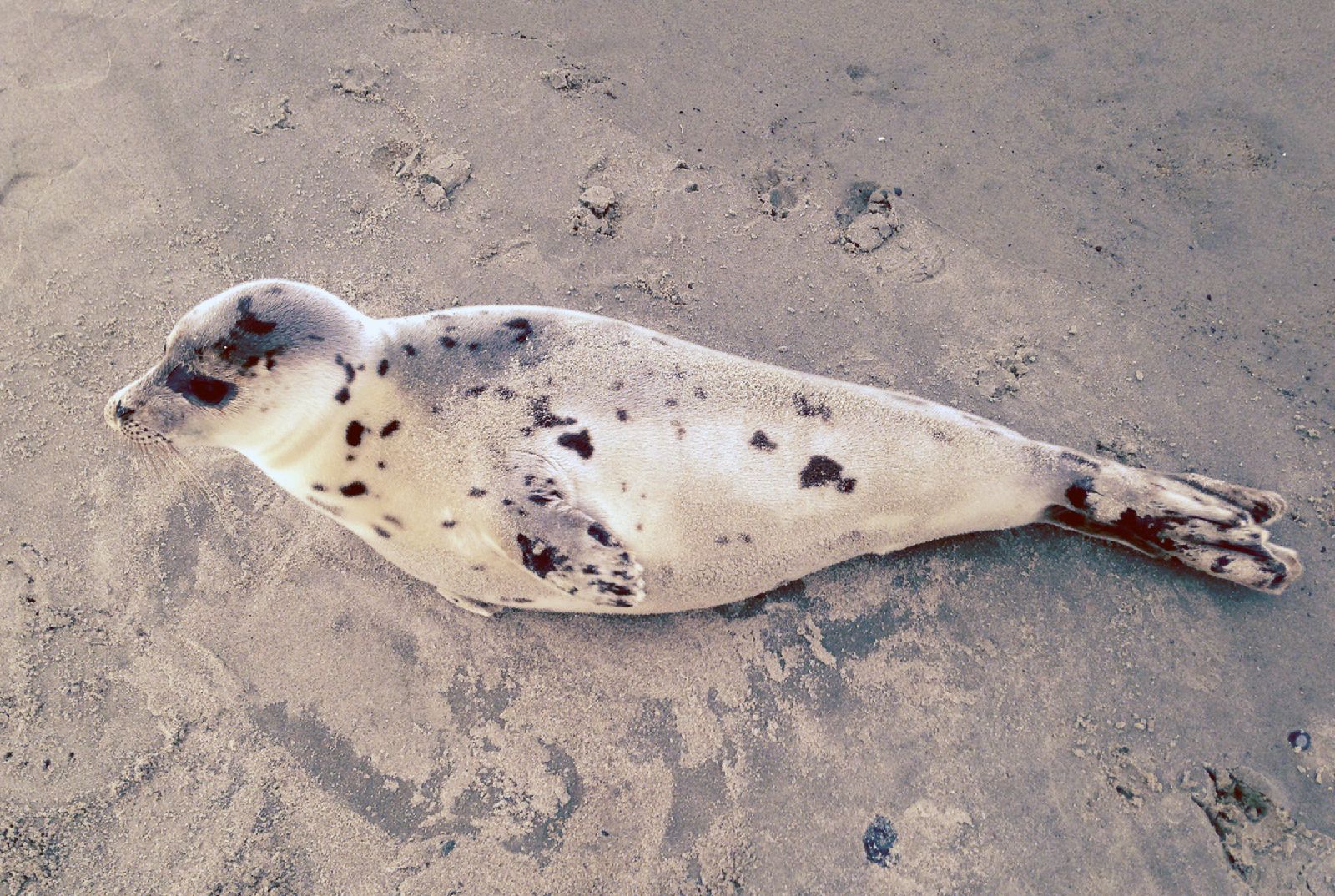 The Seacoast Science Center's Marine Mammal Rescue Team (MMRT) responded to their first harp seal (Pagophilus groenlandicus) on February 8th. The seal was observed by several beach-goers and monitored by MMRT's Rob Royer at Hampton Beach State Park before it retreated back into the water.
The Seacoast Science Center's Marine Mammal Rescue Team (MMRT) responded to their first harp seal (Pagophilus groenlandicus) on February 8th. The seal was observed by several beach-goers and monitored by MMRT's Rob Royer at Hampton Beach State Park before it retreated back into the water.
Granted authorization by the National Marine Fisheries Service to lead New Hampshire's marine mammal rescue effort, effective January 1, 2014, the Center's Team responds to stranded, injured and diseased seals, whales, porpoises, and dolphins in New Hampshire's coastal region.
Harp seals are typically only seen in New Hampshire during the winter. Adults are easily identified by the dark harp-like shape on their coats and are approximately 5-6 feet long and weight around 300 pounds. Females give birth from late February through March.
Unlike whales or dolphins, seals are semi-aquatic and are comfortable out of the water. Most seals haul out onto beaches to sleep, nurse, or to soak up the sun. Seals are cute, but they are wild animals and should not be disturbed.
According to MMRT's Coordinator, Ashley Stokes, "Everyone did the right thing; they did not approach the animal and they called our hotline to report it. Seals and other marine mammals are federally protected; anyone who disturbs them is subject to penalty and risks injury. It also puts the health of the animal in jeopardy."


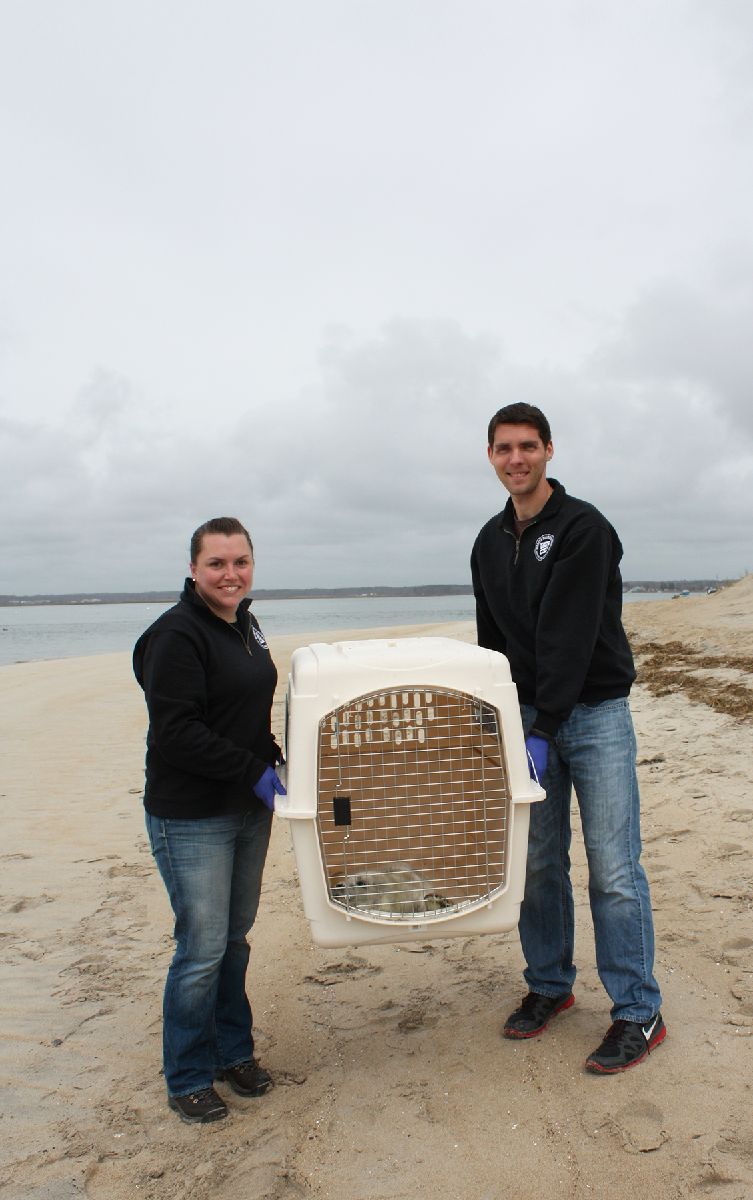
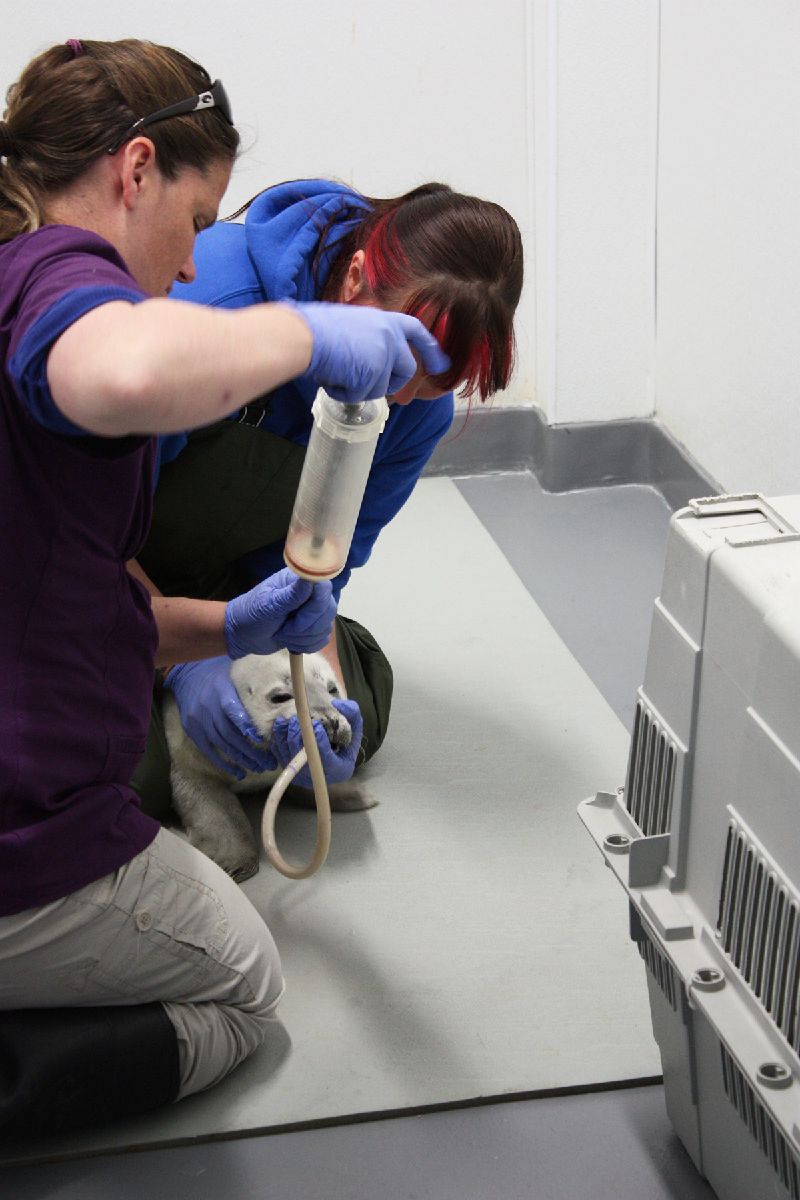
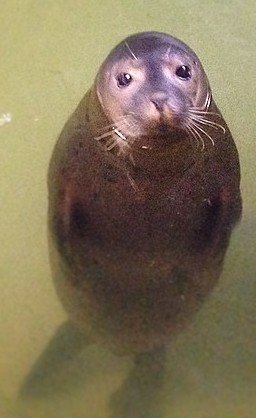
.JPG)
